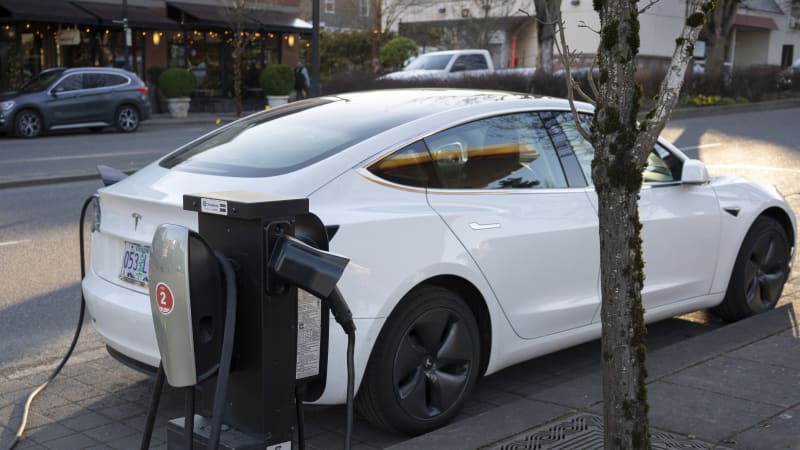
A Tesla Model 3 at a curbside EV charging station in Lake Oswego, Oregon. (Getty Images)
Oregon Live reports that Oregon will be the third state to follow California’s decision mandating 100% zero-emissions new vehicle sales by 2035. The Environmental Quality Commission voted 3-1 to adopt what’s called the Advanced Clean Car II Rule (ACCII), the fourth measure in a recent series of rulemaking that includes the Advanced Clean Trucks Rule, the Climate Protection Program, and the Clean Fuels Expansion Program. The plan is that by January 1, 2026, 35% of a manufacturer’s vehicle sales in the state will be battery-electric cars, hydrogen fuel cell vehicles, and plug-in hybrids. Come 2035, the percentage rises to 100%.
ICE-powered vehicles already on the road can remain, but ACCII revises the testing definitions and requirements of gas-powered vehicles that will go on sale up to 2035 so as to “reduce cold-start emissions and lower maximum exhaust and evaporative emission rates.” Oregonians will be able to buy new gas-powered vehicles outside the state and buy used gas-powered vehicles inside the state.
Attempting to ensure useful EVs for most residents, the ACCII rule text says pure-electric vehicles need to have at least 150 miles of real-world range on a charge, fast-charge capability, come standard with a charge cable at least 20 feet long that can handle Level 2 rates, and will need to satisfy “minimum warranty and durability requirements.” The major battery warranty stipulations match many advertised already, such as eight years of coverage or 100,000 miles, and 80% of capacity remaining at the end of that time. Plug-in hybrids will need to have an EPA-rated all-electric range of at least 50 miles as well as have “an extended warranty on emission related components for 15 years or 150,000 miles, and include similar charging capabilities, inlets, and charging cords as that of ZEVs.” One welcome stipulation is that manufacturers must provide repair information and all necessary maintenance tools to non-dealer shops.
In addition, the ACCII wants to make sure EVs are affordable for low-income households, that dealers who offer low-income assistance programs get a supply of used EVs, and it provides incentives for manufacturer’s to help community car share programs acquire EVs.
Commission spokesperson Rachel Sakata said that of the 700 responses submitted during the public comment period, 200 were against. Greg Addington, the one commissioner to vote against the rule, said, “There are a lot of people in the state who don’t get where this is going,” especially those in rural parts highlighting the lack of infrastructure to go the distances they need.
Leah Feldon, interim director of the Department of Environmental Quality, suggested looking ahead to the long-term. “These rules are a support mechanism, they are not the driving force. They would create a signal in Oregon: Bring your zero emission cars here, bring the infrastructure, and for the grid, get it ready.”
